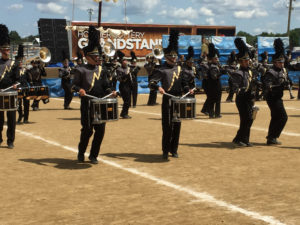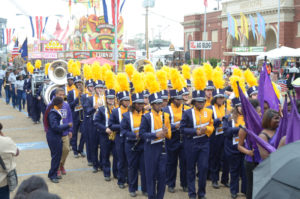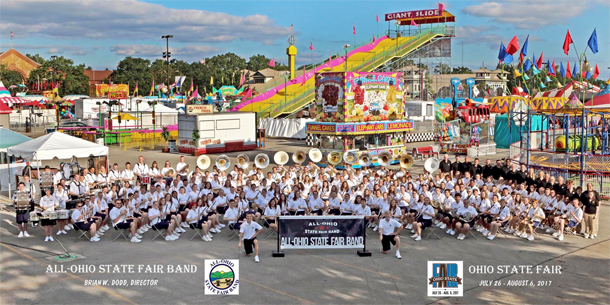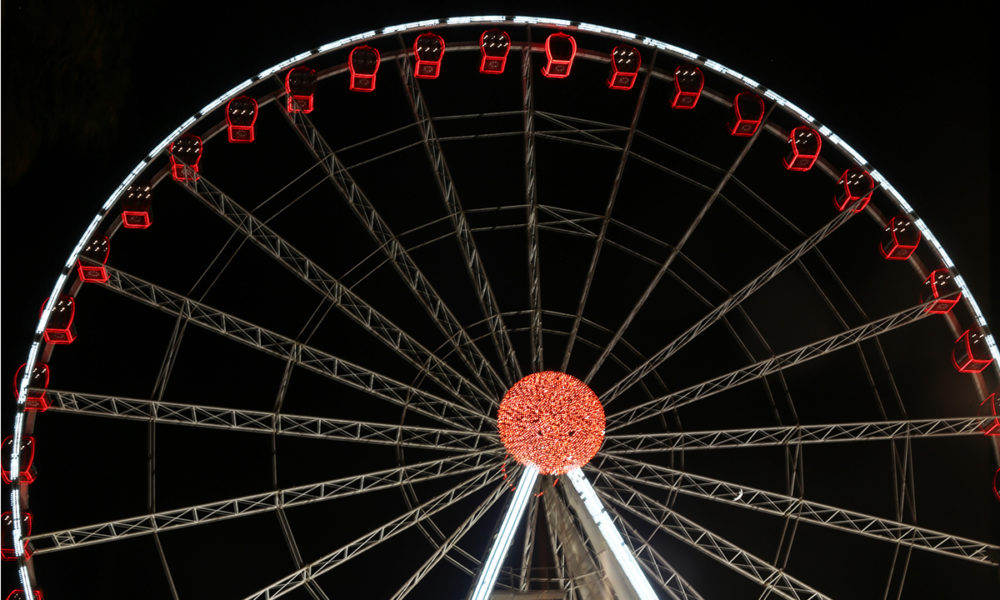From competitions and parades to paid performances, state fairs offer various opportunities for marching bands. Find out about popular activities at state fairs in Indiana, Iowa, Louisiana, and Ohio.
Don’t miss it; don’t even be late! A grand American tradition, a state fair gathers together the best in agriculture, livestock, arts and crafts, food, fun, and of course, live entertainment. Marching bands make up an important part of that tradition although each state has its own special way of including them.
Indiana
 The Indiana State Fair Band Day, held in Indianapolis on Aug. 4 this year, spawned an entire competitive circuit and non-traditional band season structure for participating groups. The original iteration of band day started in 1947 when bands would march around the track like a traditional parade. When participation started to wane as the popularity of field show competitions rose, the state fair adapted, inventing track shows.
The Indiana State Fair Band Day, held in Indianapolis on Aug. 4 this year, spawned an entire competitive circuit and non-traditional band season structure for participating groups. The original iteration of band day started in 1947 when bands would march around the track like a traditional parade. When participation started to wane as the popularity of field show competitions rose, the state fair adapted, inventing track shows.
“They put yard lines out on the track,” says Eric Thornbury, director of bands at Noblesville High School, the 2017 Indiana State Fair Band Day champions. “It’s literally just a marching band competition like you would find anywhere else. The only difference is that it’s on a track, so it’s not as wide as a football field. We still use 100 yards, but it goes to about 12 steps behind the front hash.”
The extremely competitive event features up to 50 bands each year, with more on the waiting list. Though the level of performance and hard work rivals the bands seen in field show circuits, the shows tend to go a bit smaller due to the shorter season, smaller space, and shorter show length (six minutes max).
 “I feel like we still achieve a high level of execution but with an easier product,” Thornbury says. “They still get the same great experience and all the benefits of marching band in six weeks instead of three months.”
“I feel like we still achieve a high level of execution but with an easier product,” Thornbury says. “They still get the same great experience and all the benefits of marching band in six weeks instead of three months.”
As track shows became more elaborate, the Central Indiana Track Show Association (CITSA) formed to run several invitational events in the weeks leading up to the state fair, some which coincide with county fairs. The Indiana State School Music Association also instituted a “Summer Showcase” that takes place after the fair, so that bands can perform their track shows and be recognized scholastically for their efforts.
“One of the cool things about the track show is that it’s a little bit more laidback than the field show circuit,” Thornbury says. “You show up and you go wherever you want to warm up. … It’s less punitive, and there’s no one giving out penalties. … The awards presentations are like a big party with beach balls, vuvuzelas buzzing, and flags waving.”
Plus, the track show competitions give out prize money. For the Indiana State Fair Band Day, the winning band receives $3,600, and every participating band down to last place gets some money.
“We’re all in this together; it doesn’t matter whether you’re first place or last place,” Thornbury says. “We’re all giving up our summer and practicing nine hours a day to try and perfect these shows and play music and execute drill and visuals at the highest level, and there’s a really cool kind of respect.”
Recently, Music for All and Music Travel Consultants started sponsoring the Indiana State Fair Band Day and CITSA. The funds have allowed CITSA to provide bands with quality clinician visits and to start a solo and ensemble festival.
Iowa
 The Iowa State Fair Parade, held this year on Aug. 8, kicks off the yearly celebration on the eve of opening day. As an agriculturally focused state, Iowa’s fair participants often stay in Des Moines for some or all of the 11-day fair, bringing an exciting buzz to the night before everything opens.
The Iowa State Fair Parade, held this year on Aug. 8, kicks off the yearly celebration on the eve of opening day. As an agriculturally focused state, Iowa’s fair participants often stay in Des Moines for some or all of the 11-day fair, bringing an exciting buzz to the night before everything opens.
As the biggest parade in Iowa, the State Fair Parade gives marching bands the opportunity to be seen by thousands live, even more watching on TV, and now online as well.
“We always televise the parade, and last year was our first year to livestream it,” says Mindy Williamson, Iowa State Fair marketing director.
Though the parade is more for fun than for competition, the marching bands can win awards and receive a commemorative plaque for Governor’s Cup, Governor’s Cup Runner-Up, and Best Drumline. Typically, about six bands participate each year.
“I know they’re very prideful; they’re wonderful,” Williamson says. “We love to cover them in our TV coverage, and it’s great to see various marching bands—from small schools to our large metro schools—show up. They’re all a little unique and different.”
Band participation in the state fair may soon expand further. When the state fair paused motor racing in 2016 to demolish the Iowa State Fair Speedway, organizers announced plans for a new motor sports arena, opening in 2019, that can also host rodeo events and possibly a marching band competition. “Nothing is on our schedules right now, but it’s our hope for the future,” Williamson says.
Louisiana
 The State Fair of Louisiana in Shreveport happens a bit later in the fall, running from Oct. 25 to Nov. 11 this year, allowing the celebration to continue through Veterans Day. In 2012, the local Veterans Celebration Committee partnered with the State Fair for a new parade to honor all those that have served in the military.
The State Fair of Louisiana in Shreveport happens a bit later in the fall, running from Oct. 25 to Nov. 11 this year, allowing the celebration to continue through Veterans Day. In 2012, the local Veterans Celebration Committee partnered with the State Fair for a new parade to honor all those that have served in the military.
“We decided that we wanted to do something to honor our veterans, and we wanted to minimize the cost,” says committee chairman Ken Epperson. “We thought that it would be a good idea to partner with the state fair. We developed that idea, and it increased attendance at the fairgrounds.”
Combining the parade with the state allows the organizers to avoid the cost and hassle of street closures, liability insurance, traffic, and security. Plus, it guarantees a great audience.
“It’s a good, safe, close, captured audience, and all the schools love to get in, participate, and showcase their talents,” Epperson says. “It brings so much joy for our veterans; they just love it.”
The parade route through the fair midway totals about one mile, and about 12 bands usually participate alongside the JROTC groups, cheerleaders, and cars carrying the honored veterans. In the staging area, bands interact with each other and start impromptu performances and friendly band battles in the shadow of Independence Stadium.
“We have a lot of camaraderie and everybody getting to know each other,” Epperson says. “When we start staging, they’ll be playing their songs and tunes in a little competition while getting in place for the lineup.”
Between the Veterans Day holiday, the last day of the fair, and the parade, attendance has soared up to 60,000 people. To show appreciation, all retired and active duty military and their families receive free admission that day. The parade performers also get to explore the fair.
According to Epperson, the bands love the opportunity to honor the veterans while doing one of their last marching performances of the year before heading into concert band season.
“It’s something I think everybody should do to honor our veterans as well as enlighten and educate our young people in our schools about the sacrifices that were made on behalf of this nation, so that we could enjoy the freedoms that we do,” Epperson says.
Ohio
 In a tradition dating back to 1925, the All-Ohio State Fair Band brings together the state’s best high school musicians to live and work for two weeks as an in-house band. The 220 members (or a subset of them) perform eight to 10 times daily for fairgoers before passing out in their barracks nightly.
In a tradition dating back to 1925, the All-Ohio State Fair Band brings together the state’s best high school musicians to live and work for two weeks as an in-house band. The 220 members (or a subset of them) perform eight to 10 times daily for fairgoers before passing out in their barracks nightly.
“I love the fact that we take all these kids from all over the state of Ohio, and we put them together and make a big musical unit,” says Brian Dodd, the sixth director in the band’s 93-year history. “You’ve got kids from the inner city that have never seen a farm come up here and see their first cow, and you got a kid who lives on a farm who’s never been to downtown Columbus.”
The highly competitive program starts with several full days of rehearsal to learn the nearly 80-piece song book, which includes around 20 marches. For the fair’s 12 days, from July 25 to Aug. 5 this year, the band does at least one parade per day and many “ballyhoos,” where they march through the fairgrounds with several performance stops along the way. In the late afternoons, they do a sit-down concert in the fair’s performance center for several thousand guests. Sometimes the band splits in half, so musicians can be at both ends of the fairground. Smaller ensembles such as percussion groups, brass combos, or flute choirs may take on other gigs throughout the fairgrounds to fit the ambience of the different events and venues. Four times during the fair, they perform in a major coliseum show, marching before equestrian events.
“It’s incredible the tradition that it has become down there,” Dodd says. “It is a big part of the Ohio State Fair. We get very positive reactions during the fair, and all year long people ask about it.”
The musicians perform in polo shirts and are often seen marching around carrying their own chairs and with matching backpacks where they store their music and folding stands. They can plop down and set up anywhere, with the percussion van following just behind. The repertoire spans from Ohio’s official rock song, “Hang On, Sloopy,” to tunes from “Star Wars” or “The Phantom of the Opera.”
They end nearly every performance with “The Stars and Stripes Forever” in honor of John Philip Sousa, who once guest conducted back when the band was the All-Ohio Boys’ State Fair Band in the 1920s.
The band program (not to mention the All-Ohio choir that lives next door) is completely funded by the state, including all meals, room and board, and full-time laundry. An instrument repair person and music librarian, several assistant directors, and additional staff support the band.
The alumni association is so strong that it even provides several college scholarships and funds fun events for the band like pizza parties and ice cream socials. The connections and friendships formed can be life-changing and lifelong for the band members.
“I can think of three marriages just in the 12 years I’ve been here,” Dodd says. “We’ve had so many marriages and lifetime friendships come out of this unit. That’s probably one of the best things about it.”


